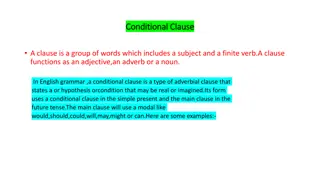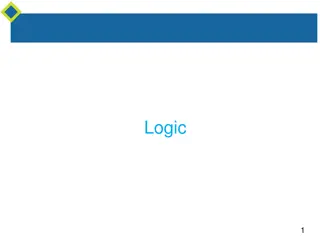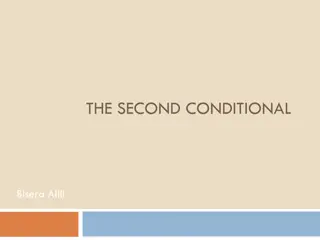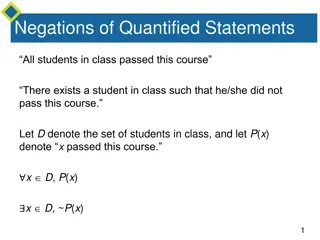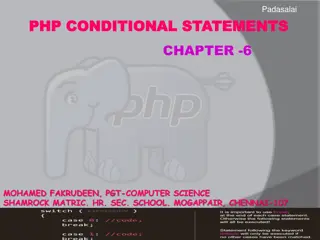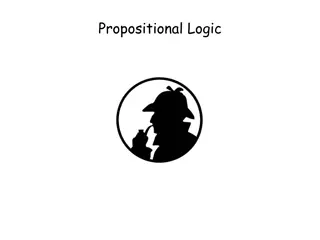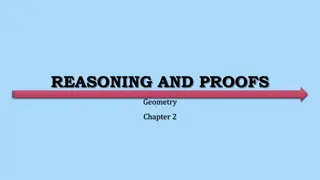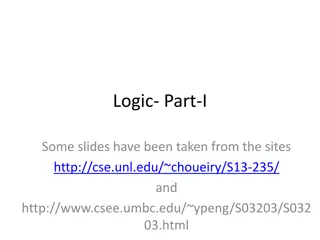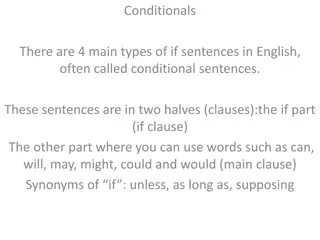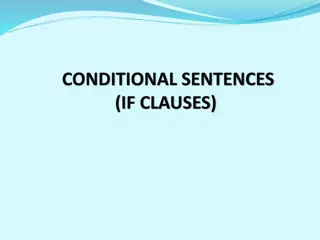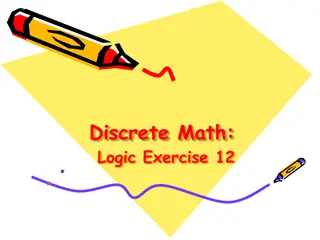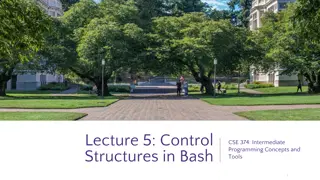Understanding Conditional Statements in Logic
Conditional statements in logic involve connecting statements with an "if-then" structure. The truth of the conclusion is dependent on the truth of the hypothesis. Explore examples, truth tables, and logical equivalences to grasp the concepts of conditional statements.
Download Presentation

Please find below an Image/Link to download the presentation.
The content on the website is provided AS IS for your information and personal use only. It may not be sold, licensed, or shared on other websites without obtaining consent from the author. Download presentation by click this link. If you encounter any issues during the download, it is possible that the publisher has removed the file from their server.
E N D
Presentation Transcript
Conditional Statements Let p and q be statements. A sentence of the form If p then q is denoted symbolically by p q ; p is called the hypothesis and q is called the conclusion. For instance, consider the following statement: Such a sentence is called conditional because the truth of statement q is conditioned on the truth of statement p. 1
Conditional Statements The notation p q indicates that is a connective, like or , that can be used to join statements to create new statements. To define p q as a statement, therefore, we must specify the truth values for p q as we specified truth values for p q and for p q. 2
Conditional Statements Truth Table for p q 3
Conditional Statements A conditional statement that is true by virtue of the fact that its hypothesis is false is often called vacuously true or true by default. Thus the statement If you show up for work Monday morning, then you will get the job is vacuously true if you do not show up for work Monday morning. In general, when the if part of an if-then statement is false, the statement as a whole is said to be true, regardless of whether the conclusion is true or false. 4
Example 1 A Conditional Statement with a False Hypothesis Consider the statement: If 0 = 1 then 1 = 2. As strange as it may seem, since the hypothesis of this statement is false, the statement as a whole is true. 5
Conditional Statements In expressions that include as well as other logical operators such as , , and , the order of operations is that is performed last. Thus, according to the specification of order of operations, is performed first, then and , and finally . 6
Example 2 Truth Table for p q p Construct a truth table for the statement form p q p. Solution: 7
Example 3 Division into Cases: Showing that p q r ( p r) (q r) Use truth tables to show the logical equivalence of the statement forms p q r and (p r ) (q r). Annotate the table with a sentence of explanation. Solution: 10
Representation of If-Then As Or Use truth tables to show p q p q 14
Example 4 Application of the Equivalence between p q and p q Rewrite the following statement in if-then form. Either you get to work on time or you are fired. Solution: Let p be You get to work on time. and q be You are fired. Then the given statement is p q. Also p is You do not get to work on time. So the equivalent if-then version, p q, is If you do not get to work on time, then you are fired. 15
The Negation of a Conditional Statement By definition, p q is false if, and only if, its hypothesis, p, is true and its conclusion, q, is false. It follows that This can be restated symbolically as follows: 16
Example 5 Negations of If-Then Statements Write negations for each of the following statements: If my car is in the repair shop, then I cannot get to class. Solution: My car is in the repair shop and I can get to class. 17
The Contrapositive of a Conditional Statement One of the most fundamental laws of logic is the equivalence between a conditional statement and its contrapositive. The fact is that 18
Example 6 Writing the Contrapositive Write each of the following statements in its equivalent contrapositive form: If today is Easter, then tomorrow is Monday. Solution: If tomorrow is not Monday, then today is not Easter. 19
The Converse and Inverse of a Conditional Statement The fact that a conditional statement and its contrapositive are logically equivalent is very important and has wide application. Two other variants of a conditional statement are not logically equivalent to the statement. 20
Example 7 Writing the Converse and the Inverse Write the converse and inverse of each of the following statement: If today is Easter, then tomorrow is Monday. Solution: Converse: If tomorrow is Monday, then today is Easter. Inverse: If today is not Easter, then tomorrow is not Monday. 21
The Converse and Inverse of a Conditional Statement 1. A conditional statement and its converse are not logically equivalent. 2. A conditional statement and its inverse are not logically equivalent. 3. The converse and the inverse of a conditional statement are logically equivalent to each other. 22
Only If and the Biconditional To say p only if q means that p can take place only if q takes place also. That is, if q does not take place, then p cannot take place. Another way to say this is that if p occurs, then q must also occur (by the logical equivalence between a statement and its contrapositive). 23
Example 8 Converting Only If to If-Then Rewrite the following statement in if-then form in two ways, one of which is the contrapositive of the other. John will break the world s record for the mile run only if he runs the mile in under four minutes. Solution: Version 1:If John does not run the mile in under four minutes, then he will not break the world s record. Version 2:If John breaks the world s record, then he will have run the mile in under four minutes. 24
Only If and the Biconditional The biconditional has the following truth table: Truth Table for p q 25
Only If and the Biconditional In order of operations , the only way to indicate precedence between them is to use parentheses. is coequal with . As with and The full hierarchy of operations for the five logical operators is: 26
Only If and the Biconditional According to the separate definitions of if and only if, saying p if, and only if, q should mean the same as saying both p if q and p only if q. The following annotated truth table shows that this is the case: Truth Table Showing that p q (p q) (q p) 27
Example 9 If and Only If Rewrite the following statement as a conjunction of two if-then statements: This computer program is correct if, and only if, it produces correct answers for all possible sets of input data. Solution: If this program is correct, then it produces the correct answers for all possible sets of input data; and if this program produces the correct answers for all possible sets of input data, then it is correct. 28
Necessary and Sufficient Conditions The phrases necessary condition and sufficient condition, as used in formal English, correspond exactly to their definitions in logic. In other words, to say r is a sufficient condition for s means that the occurrence of r is sufficient to guarantee the occurrence of s. 29
Necessary and Sufficient Conditions On the other hand, to say r is a necessary condition for s means that if r does not occur, then s cannot occur either: The occurrence of r is necessary to obtain the occurrence of s. Note that because of the equivalence between a statement and its contrapositive, Consequently, 30
Example 10 Interpreting Necessary and Sufficient Conditions Consider the statement If John is eligible to vote, then he is at least 18 years old. The truth of the condition John is eligible to vote is sufficient to ensure the truth of the condition John is at least 18 years old. In addition, the condition John is at least 18 years old is necessaryfor the condition John is eligible to vote to be true. If John were younger than 18, then he would not be eligible to vote. 31




